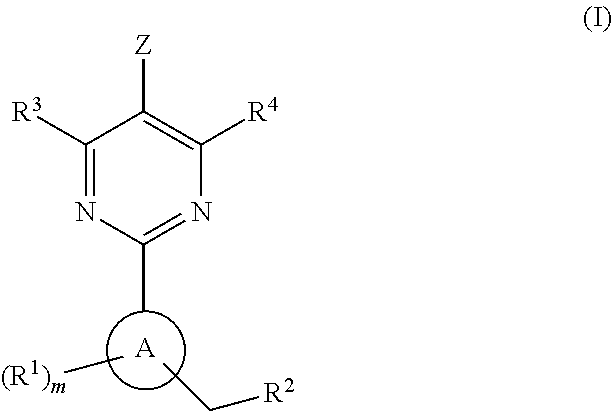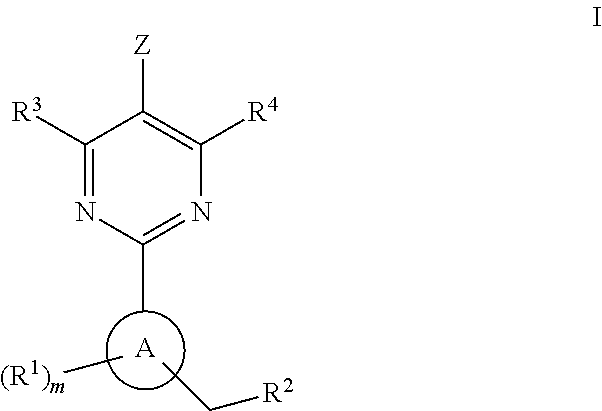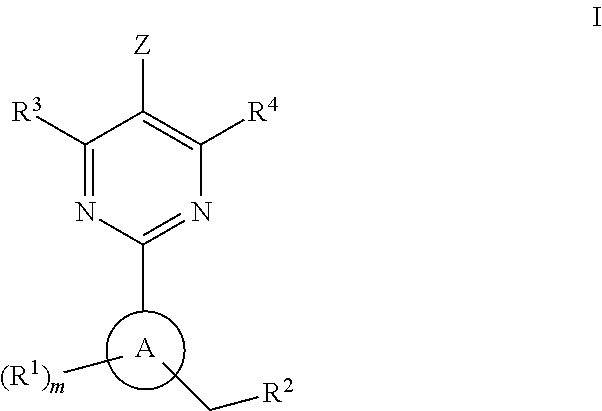Soluble guanylate cyclase activators
a guanylate cyclase and activator technology, applied in the field of soluble guanylate cyclase activators, can solve the problems of increased dosage, increased tolerance, and reduced activity of poisons, and achieves the effect of only weakening the formation of cgmp, and reducing the number of toxic substances
- Summary
- Abstract
- Description
- Claims
- Application Information
AI Technical Summary
Benefits of technology
Problems solved by technology
Method used
Image
Examples
example 1
5-bromo-2-iodopyrimidin-4-amine
[0156]
Step A
[0157]To a solution of 2,4-dichloro-4-bromo pyrimidine (5 g, 21.9 mmol) cooled to 0° C. was added hydriodic acid (50 mL, 379 mmol). The ice-bath was removed and the resulting mixture was stirred vigorously at room temperature for 18 hours. The reaction mixture was quenched by pouring into saturated bicarbonate solution. The resulting mixture was extracted with ethyl acetate (3×). The organic layer was washed with sodium thiosulfate solution, dried over anhydrous sodium sulfate filtered and concentrated to give a white solid.
Step B
[0158]To a solution of the intermediate from step A (1 g, 2.4 mmol) in THF (10 mL) in a pressure tube was bubbled ammonia gas for 20 minutes. The tube was capped and heated at 70° C. for one hour. The reaction mixture was cooled to room temperature and concentrated. The residue was suspended in ethyl acetate and washed with water. The organic layer was washed with brine, dried over anhydrous sodium sulfate filtered...
example 2
2-[7-(2,3,6-trifluorobenzyl)imidazo[1,5-b]pyridazin-5-yl]-5-(1,3,5-trimethyl-1H-pyrazol-4-yl)pyrimidin-4-amine
[0159]
Step A
[0160]To a solution of pyridazine (3.63 ml, 49.9 mmol) in DCM (60 ml) was added trimethyl silyl cyanide (11.99 ml, 90 mmol) and aluminum chloride (20 mg, 0.150 mmol). After stirring the reaction mixture at room temperature for 10 minutes, a solution of para-toluene sulfonyl chloride (16.38 ml, 86 mmol) in DCM (100 mL) was added drop-wise via an addition funnel over 30 minutes. The resulting light orange solution was left stirring at room temperature for 18 hours. The reaction mixture was concentrated to give a light brown solid. To this material was added EtOH (100 mL) A white precipitate crashed out which was filtered through a sintered funnel, washed with ethanol (50 mL) and collected. LC-MS: m / z=262 (M+1); rt=1.4 min (Method C).
Step B
[0161]To a solution of the intermediate from Step A (10 g, 38.3 mmol) in anhydrous THF (90 ml) was added DBU (7.21 ml, 47.8 mmo...
example 3
5-[1,5-dimethyl-3-(trifluoromethyl)-1H-pyrazol-4-yl]-2-[7-(2,3,6-trifluorobenzyl)imidazo[1,5-b]pyridazin-5-yl]pyrimidin-4-amine
[0169]
Step A
[0170]To a solution of 5-methyl-3-(trifluoromethyl)-1H-pyrazole (3.5 g, 23 mmol) in anhydrous DMF (50 mL) was added sodium hydride (1.2 g, 30 mmol). After 5 minutes, iodomethane (1.97 mL, 31.5 mmol) was added. The reaction was stirred at room temperature for 1 hour, and quenched with water. The resulting mixture was extracted with ether. The organic layer was dried over anhydrous magnesium sulfate, filtered, and concentrated.
Step B
[0171]To a solution of the intermediate from step A (23 mmol) in acetic acid (23 mL) was added bromine (3.73 g, 23.32 mmol). After stirring at room temperature for 1 hour it was quenched by adding sodium sulfite and water. The resulting mixture was concentrated. The residue was diluted with ethyl acetate and washed with saturated sodium carbonate solution, brine, dried over anhydrous sodium sulfate, filtered and concent...
PUM
| Property | Measurement | Unit |
|---|---|---|
| pressure | aaaaa | aaaaa |
| temperature | aaaaa | aaaaa |
| temperature | aaaaa | aaaaa |
Abstract
Description
Claims
Application Information
 Login to View More
Login to View More - R&D
- Intellectual Property
- Life Sciences
- Materials
- Tech Scout
- Unparalleled Data Quality
- Higher Quality Content
- 60% Fewer Hallucinations
Browse by: Latest US Patents, China's latest patents, Technical Efficacy Thesaurus, Application Domain, Technology Topic, Popular Technical Reports.
© 2025 PatSnap. All rights reserved.Legal|Privacy policy|Modern Slavery Act Transparency Statement|Sitemap|About US| Contact US: help@patsnap.com



